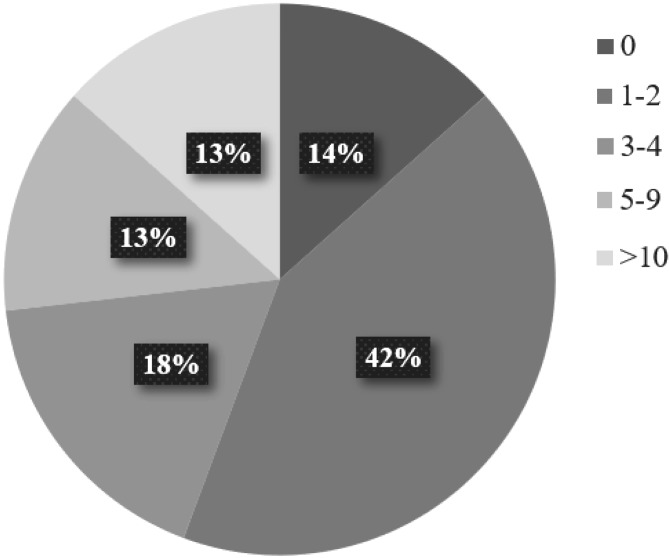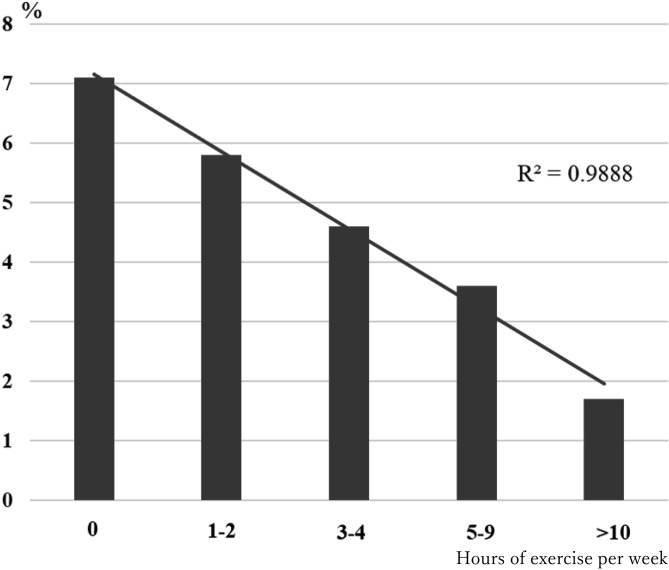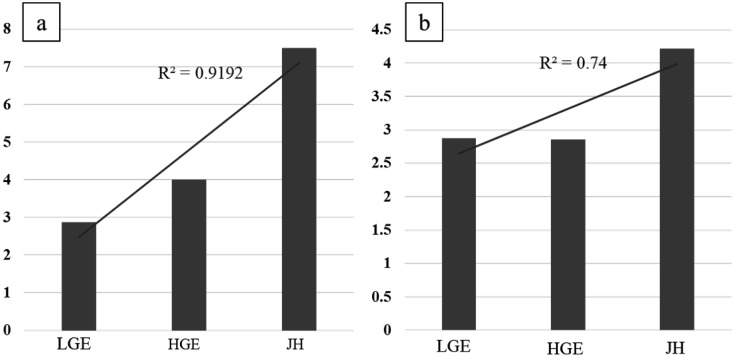Abstract
Objectives: The purpose of this study was to evaluate the relationship between exercise time and musculoskeletal problems and to determine the appropriate amount of exercise for children in both lower- and higher-grade levels of elementary and junior high schools.
Materials and Methods: Mark-sheet-type questionnaires were distributed to and collected from all elementary and junior high schools in two cities. We collected 22,494 questionnaires in total. The relationship between exercise time and musculoskeletal problems was analyzed. The χ2 test and multivariate logistic regression analysis were used for statistical analyses.
Results: The mean exercise time in school, in addition to physical education time, was 3.1 hours per week. In 56% of the children, the exercise time was less than 2 hours per week, and in 13% of the children, the exercise time was more than 10 hours per week. Although the rate of sports injury increased with an increase in exercise time, the duration of one-leg stand (a test of balance and muscle strength) also increased with an increase in exercise time. The cut-off values for sports injuries in boys/girls were 2.9/2.9 hours, 4.0/2.9 hours, and 7.5/4.2 hours in lower grade elementary school, higher grade elementary school, and junior high school, respectively.
Conclusions: Although an appropriate amount of exercise improves one’s physical health and ability, excessive exercise leads to musculoskeletal problems. Approximately 7 hours/week of exercise is recommended for junior high school students. In elementary school, the exercise time should be carefully decided as the musculoskeletal system of the students is still immature.
Keywords: musculoskeletal system, exercise, children
Introduction
At present, Japan has the highest proportion of elderly people in the world, and the proportion of elderly people aged 65 years or older is more than 27%1). Moreover, the mean lifespan of Japanese people is one of the longest in the world. However, not only a long lifespan but healthy lifespan are important. Prevention of musculoskeletal disorders from a young age is essential to extend the lifespan of humans. An increase in musculoskeletal problems and a decrease in physical strength are currently noteworthy problems in Japan. Generally, children are divided into two groups on the basis of exercise time; in the high-exercise group, musculoskeletal injury is a problem, whereas in the low-exercise group, decreased physical strength and diseases related to low exercise time are the main issues. To prevent and detect musculoskeletal problems early, screening for musculoskeletal disorders of the extremities, in addition to screening for scoliosis, was started in 2016 in Japan. In 2007, the University of Tsukuba started musculoskeletal screening. Moreover, from 2016, at the time of the initial nationwide screening of the extremities, the University of Tsukuba started using mark-sheet-type questionnaires to improve the efficacy of screening. These questionnaires contained questions related to exercise time and history of musculoskeletal problems. From this information, researchers are able to examine the relationship between exercise time and musculoskeletal problems. Although appropriate amounts and methods of exercise help in the development of a healthy musculoskeletal system and prevent musculoskeletal disorders, excessive exercise can damage the musculoskeletal system. The purpose of this study was to evaluate the relationship between exercise time and musculoskeletal problems and to determine the appropriate amount of exercise for the healthy development of the musculoskeletal system and the prevention of musculoskeletal disorders in children in lower- and higher-grade levels of elementary and junior high school.
Materials and Methods
All procedures for this study were approved by the ethics board of the University of Tsukuba. All procedures were performed after informed consent was obtained from the participants.
Mark-sheet-type questionnaires were distributed and collected from all elementary and junior high schools in Tsukuba City and Hitachiomiya City. We collected 22,494 questionnaires in total and the collection rate was 99%. The questionnaire was originally created by the University of Tsukuba and based on the Japan Association of School Health’s questionnaire. The questionnaire contained questions related to the exercise time in school (excluding physical education time); presence of scoliosis; stand flexion exercise; full-squat exercise; one-leg stand; and the presence of genu valgum, genu varum, flat feet, fracture or joint dislocation, Osgood disease, baseball elbow, and spondylolysis. The question relating to exercise time had the following possible responses: 1) 0 hours, 2) 1–2 hours, 3) 3–4 hours, 4) 5–9 hours, and 5) 10 hours or more.
Statistical analysis
Students were divided into two groups on the basis of the exercise time. Using the median value of exercise time, participants with more than 3 hours of exercise time were categorized as the high-exercise group, and those with less than 3 hours of exercise time were categorized as the low-exercise group. The rate of musculoskeletal problems was compared between the groups using the χ2 test. Multivariate logistic regression analysis was also performed; the musculoskeletal problem was set as the objective variable and the exercise time, school year, sex, and mode of going to school were set as explanatory variables. A p-value < 0.05 indicated statistical significance. All statistical analyses were performed with JMP Statistics, version 13.2.1 (SAS Institute Inc.).
Results
The mean exercise time in school, in addition to physical education time, was 3.1 hours per week. In 56% the children the exercise time was less than 2 hours per week, while 13% of the children exercised more than 10 hours per week (Figure 1). The rate of sports injuries (i.e., fracture or dislocation, fatigue fracture, Osgood disease, baseball elbow, and spondylolysis) increased as the exercise time increased (Figure 2). In addition, the duration of one-leg stands increased as exercise time increased (Figure 3). The exercise time and the rate of musculoskeletal problems were correlated significantly; the details are shown in Table 1. When the exercise time increased, the abnormal durations of stand flexion and one-leg stand decreased significantly (p < 0.05, χ2 test). In contrast, when the exercise time increased, the abnormal rates of full squats and the presence of fracture or dislocation, Osgood disease, baseball elbow, spondylolysis, and fatigue fracture also increased. The rate of sports injury and balance ability (one-leg stand) also increased with exercise.
Figure 1.
Exercise time (hours per week) in addition to physical education time in schools.
Figure 2.
Rate of sports injuries (i.e., fracture or dislocation, fatigue fracture, Osgood disease, baseball elbow, and spondylolysis) and exercise time.
Figure 3.
Abnormal rate of one-leg stands and exercise time.
Table 1. Relationship between exercise time and abnormal rate of musculoskeletal problems in lower- and higher-grade elementary and junior high school in boys and girls.
| Lower-grade elementary | Higher-grade elementary | Junior high school | Total | ||||
|---|---|---|---|---|---|---|---|
| Boy | Girl | Boy | Girl | Boy | Girl | ||
| Scoliosis | n.s. | n.s. | n.s. | P<0.05* | n.s. | n.s. | n.s. |
| Stand flexion | P<0.001* | P<0.001* | P<0.001* | P<0.001* | P<0.001* | P<0.01* | n.s. |
| One-leg stand | P<0.001* | P<0.001* | P<0.001* | P<0.01* | P<0.01* | P<0.01* | P<0.001* |
| Full squat | n.s. | n.s. | P = 0.001* | n.s. | n.s. | P<0.01† | P<0.001† |
| Flat feet | P<0.01* | P<0.001* | P<0.001* | P<0.001* | P<0.001† | P<0.001† | n.s. |
| Fracture or joint dislocation | n.s. | n.s. | P<0.001† | P<0.05† | P<0.001† | n.s. | P<0.001† |
| Osgood disease | n.s. | n.s. | P<0.01† | n.s. | P<0.001† | P<0.05† | P<0.01† |
| Baseball elbow | n.s. | n.s. | P<0.001† | P<0.05† | P<0.001† | n.s. | P<0.01† |
| Spondylolysis | n.s. | n.s. | n.s. | n.s. | P<0.05† | n.s. | P<0.01† |
| Fatigue fracture | n.s. | n.s. | P<0.05† | n.s. | P<0.05† | P<0.001† | P<0.01† |
Comparison of the abnormal rate of musculoskeletal problems between the high-exercise and low-exercise groups in lower-grade level boys/girls and higher-grade level boys/girls in elementary and junior high school. *Significantly low in the high-exercise group (χ2 test). †Significantly high in the high-exercise group (χ2 test). n.s.: not significant.
In the multivariate logistic regression analysis, stand flexion; one-leg stand; and the presence of fracture or dislocation, Osgood disease, baseball elbow, and spondylolysis were significantly correlated with exercise time. Exercise decreased the abnormal durations of stand flexion and one-leg stand but increased the rate of sports injury (Table 2).
Table 2. Results of multivariate logistic regression analysis.
| Explanatory variables, P-value | |||||
|---|---|---|---|---|---|
| Time of exercise | Grade in school | Sex | Mode of going to school | ||
| Objective variables | |||||
| Scoliosis | n.s. | 0.001 | n.s. | n.s. | |
| Stand flexion | < 0.001 | < 0.001 | < 0.001 | n.s. | |
| Full squat | n.s. | < 0.001 | < 0.001 | n.s. | |
| One-leg stand | < 0.001 | < 0.001 | < 0.001 | < 0.001 | |
| Genu valgum | n.s. | n.s. | n.s. | n.s. | |
| Genu varum | n.s. | < 0.001 | 0.01 | n.s. | |
| Flat feet | n.s. | < 0.001 | < 0.001 | n.s. | |
| Fracture or dislocation | < 0.001 | < 0.001 | < 0.001 | n.s. | |
| Osgood disease | < 0.001 | < 0.001 | < 0.001 | n.s. | |
| Baseball elbow | < 0.001 | < 0.001 | < 0.001 | n.s. | |
| Spondylolysis | 0.021 | 0.009 | n.s. | n.s. | |
n.s.: not significant.
The cut-off values for sports injuries (i.e., fracture or dislocation, Osgood disease, baseball elbow, spondylolysis, and fatigue fracture) in boys/girls were 2.9/2.9 hours, 4.0/2.9 hours, and 7.5/4.2 hours in lower-grade elementary school, higher-grade elementary school, and junior high school, respectively (Table 3, Figure 4).
Table 3. Cut-off values (exercise hours) of musculoskeletal problems.
| Lower-grade elementary | Higher-grade elementary | Junior high school | Total | ||||
|---|---|---|---|---|---|---|---|
| Boys | Girls | Boys | Girls | Boys | Girls | ||
| Stand flexion | 1.5 | 1.5 | 1.5 | 1.5 | 1.5 | 0 | 7 |
| One-leg stand | 1.5 | 1.5 | 1.5 | 1.5 | 7 | 3.5 | 1.5 |
| Fracture or dislocation | 7 | 7 | 7 | 7 | 7 | 7 | 7 |
| Osgood disease | 1.5 | – | 3.5 | 0 | 10 | 7 | 7 |
| Baseball elbow | – | – | 7 | 7 | 10 | 7 | 7 |
| Spondylolysis | – | – | 7 | 1.5 | 7 | 1.5 | 7 |
| Fatigue fracture | – | 1.5 | 3.5 | 1.5 | 10 | 3.5 | 7 |
Figure 4.
Cut-off values for sports injury in boys (a) and girls (b).
LGE: Lower-grade elementary; HGE: Higher-grade elementary; JH: Junior high school.
Discussion
The World Health Organization (WHO) recommends more than 60 minutes of exercise per day for children aged 5–17 years in order to improve physical ability and health2). The Centers of Disease Control and Prevention also recommend 60 minutes of exercise per day for children3).
Legault et al. reported that adolescent athletes have fewer issues with the spine and extremities than do adolescent non-athletes4). Tokuoumaru et al. reported that after exercise of the peroneus longus and tibialis posterior muscles, heel raises were possible with few perturbations of the metatarsal head5). Smith et al. revealed that muscular fitness had a positive effect on bone health and self-esteem, but the relationship between muscular fitness and musculoskeletal pain was uncertain6). Thus, it is clear that a certain amount of exercise is beneficial to the musculoskeletal system.
However, in Japan, the time of physical education in elementary and junior high schools is approximately 2–3 hours per week; this is insufficient according to the WHO-recommended exercise time, and additional exercise, other than physical education, is necessary.7).
In contrast, excessive exercise can lead to musculoskeletal problems, such as those resulting from sporting injuries. In line with this, Shanmugam et al. revealed that when designing a training program, biological age and physical immaturity should be considered8). Zwingenberger et al. reported a higher rate of low back pain in adolescent athletes than in age-matched controls9). Finch et al. reported higher population health burden in sports injury compared with that in road traffic injury among children; this tendency was more remarkable in younger individuals than in older individuals (Table 3, Figure 4)10). Physical educators must be careful to prevent excessive exercise in young children.
There are several limitations to this study. First, information related to the exercise time was collected via a questionnaire. Therefore, we had to classify exercise time into five classes; accordingly, the accuracy of exercise time is not high. Second, this study is a cross-sectional study. A longitudinal study will more accurately detect the relationship between exercise time and musculoskeletal problems. As longitudinal data were accumulated in our group, a longitudinal study will be reported in the future.
Conclusions
About 7 hours/week of exercise for junior high school boys is recommended. As elementary school students’ musculoskeletal system is immature compared to that of junior high school students, the exercise time should be carefully decided. Further prospective study on exercise time and musculoskeletal problems is needed.
Conflict of interest and source of funding
The authors have no conflict of interest to declare and source of funding to disclose.
References
- 1.Ministry of Internal Affairs and Communications Japan. Population estimate, based on 2015. Census. http://www8.cao.go.jp/kourei/whitepaper/w-2016/html/gaiyou/s1_1.html. Accessed September 6, 2018.
- 2.World Health Organization. Physical activity and young people. http://www.who.int/dietphysicalactivity/factsheet_young_people/en/. Accessed September 6, 2018.
- 3.Centers for Disease Control and Prevention. Current physical activity guidelines, key guidelines for children and adolescents. https://www.cdc.gov/cancer/dcpc/prevention/policies_practices/physical_activity/guidelines.htm. Accessed September 6, 2018.
- 4.Legault ÉP, Descarreaux M, Cantin V. Musculoskeletal symptoms in an adolescent athlete population: a comparative study. BMC Musculoskelet Disord 2015; 16: 210. doi: 10.1186/s12891-015-0681-4 [DOI] [PMC free article] [PubMed] [Google Scholar]
- 5.Tokuoumaru K, Takahashi M, Sekikawa K. The effects of exercise of the peroneus longus and tibialis posterior muscles on heel raise. Jpn J Phys Fit Sport Med 2009; 58: 387–394. doi: 10.7600/jspfsm.58.387 [DOI] [Google Scholar]
- 6.Smith JJ, Eather N, Morgan PJ. The health benefits of muscular fitness for children and adolescents: a systematic review and meta-analysis. Sports Med 2014; 44: 1209–1223. doi: 10.1007/s40279-014-0196-4 [DOI] [PubMed] [Google Scholar]
- 7.Japan Ministry of Education Cultutre, Sports, Science and Technology. Class time of physical education. http://www.mext.go.jp/en/. Accessed September 6, 2018.
- 8.Shanmugam C, Maffulli N. Sports injuries in children. Br Med Bull 2008; 86: 33–57. doi: 10.1093/bmb/ldn001 [DOI] [PubMed] [Google Scholar]
- 9.Schmidt CP, Zwingenberger S, Walther A. Prevalence of low back pain in adolescent athletes - an epidemiological investigation. Int J Sports Med 2014; 35: 684–689. doi: 10.1055/s-0033-1358731 [DOI] [PubMed] [Google Scholar]
- 10.Finch CF, Wong Shee A, Clapperton A. Time to add a new priority target for child injury prevention? The case for an excess burden associated with sport and exercise injury: population-based study. BMJ Open 2014; 4: e005043. doi: 10.1136/bmjopen-2014-005043 [DOI] [PMC free article] [PubMed] [Google Scholar]






